ID |
Date |
Author |
Category |
Subject |
|
34
|
Sat Jun 21 02:32:24 2025 |
Alex, Anton, Rodolfo, Hiroshi, Carsten | Laser | Laser scanning setting | This is the initial scanning range
- 3 Loops
- 501 Steps
- 15 Shots / Step
- From 550.4 nm to 547.9 nm. In total 2.5 nm @ 0.005 nm
Test file on DAQ2 is 0132.lmd / 0133.lmd |
|
33
|
Sat Jun 21 01:40:31 2025 |
Carsten, Alex, Anton, Rodolfo, Hiroshi | Accelerator | beam parameters | The revolution frequency for the measurement condition is: 1.542728 MHz.
The electron cooler voltage is: 104411 V. |
|
32
|
Sat Jun 21 00:52:07 2025 |
Carsten | Accelerator | Summary of the last days (bunches wiht several isotopes still in ) / frequency of the | Initially, we has very low SIS beam intensities in the 1e8 region. Setting up ESR wiht Stacking etc. turned out to be extremly tedious for the ESR crew.
Yet, they managed to get stochastic ooling working early on.
Accumulation with the new "stochstic cooling only" scheme essentially does not saturate even after 40 injections or so.
One problem was that the beam often got lost at deceleration and not reliable / reproducable conditions could be achieved.
Also the secondary beam and partilce ID could finally be established (see earlier posts). During deceleration often the partilces were got lost again.
In the decelerated bunch at least 7 isotopes were decelerated (and not only one):
The frequencies were
@ 400 MeV/u in SC 3:
[1] 242.27986 MHz
[2] 242.82623 MHz + 27.5 kHz
[3] 242.853 MHz + 54.375 kHz 229Th
[4] 242.878 MHz + 79.375 kHz
[5] 242.936 MHz + 137.5 kHz
[6] 242.959 MHz + 160 kHz
[7] 242.982 MHz + 183.75 kHz
decelerated to 190 MeV/u:
[1] 243.6925 MHz
[2] 243.72213 MHz + 29.6 kHz
[3] 243.750 MHz + 57.375 kHz 229Th --- Reference on Schottky scope
[4] 243.7768 MHz + 84. kHz
[5] 243.8376 MHz + 145 kHz
[6] 243.863 MHz + 170.6 kHz
[7] 243.687 MHz + 194.625 kHz
Thursday night (19.6. -> 20.06.) a first scraping was established.
In order to cleanly scrape the peaks Sergey Litvinov devised a new pattern:
At the low energy (190 MeV/u) the bunch is unpacked, cooled, scraped and rebunched for the measurement.
Some details of th eabove can be found in the acclerator log.
The problem with the beam losses were solved with large cooling phases at the end of the accumulation cycle. |
|
31
|
Sat Jun 21 00:23:22 2025 |
Rodolfo | Laser | Dye | I have prepared new (fresh) dye solutions of Fluorescein 27: 2 charges. They are in the Safety Cabinet (Sicherheitsschrank) in the ESR Laser lab |
| Attachment 1: Farbstoff_FL27.jpg
|
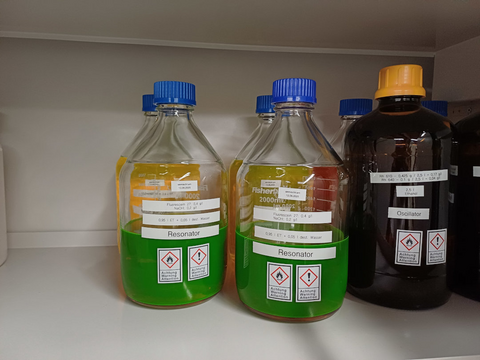
|
|
30
|
Fri Jun 20 15:58:21 2025 |
Wilfried, Konstantin, Simon | Laser | Laser stepwidth | From previous Bi-Beamtimes, we expect the width of the transition to be >50GHz (FWHM). The current step width is 0.002nm which corresponds to 8GHz, so the laser would be in resonance for 6 steps.
We should aim for at least 5 steps in resonance.
|
line width (sigma) | >20GHz
| |
FWHM | ~50GHz
| |
step width (fundamental) | 0.004nm (4GHz)
| |
step width (doubled) | 0.002nm (8GHz)
|
|
|
29
|
Fri Jun 20 11:25:32 2025 |
Julien, Kristian, Konstantin | Laser | Automated laser scans | | In contrast to entry E12, the cabling for the automated start of the laser scan is now connected to IO3 of sddsc221. |
|
28
|
Fri Jun 20 06:37:51 2025 |
Konstantin | Accelerator | Position of contaminants | I checked the positions of the contaminants. Therefore, I drove the scrapers and observed the signal at the Schottky detector
While the vertical positions are identical for all scrapers, the horizontal positions deviate due to the dispersion in the cooler section
|
Scraper | -83.75kHz | -26.875 | 0 | 61kHz | 83.25 | 110.625 | |
GECEDS1VU | -0.5 | -0.5 | -0.5 | -0.5 | -0.5 | -0.5 | |
GECEDS1HA (from 75mm) | -4 | -5 | -5.2 | -6.6 | -6.9 | -7.2 | |
GECEDS1HA (from -75mm) | -11.8 | -12.8 | -13.3 | -14.5 | -15.1 | -15.7 | |
GECEDS2VU | 0.9 | 0.9 | 0.9 | 0.9 | 0.9 | 0.9
|
|
|
27
|
Wed Jun 18 20:24:01 2025 |
Carsten, Shahab, Ragandeep, Danyal et al. (the dayshift) and ESR crew | Accelerator | 229Th89+ identification | We believe to have identified the 237U92+ and the 229Th89+ peaks.
Using the Schottky resonator at about 244 MHz and taking the 123rd harmonic:
The Schottky peak of 237U92+ should be at 242.7975 MHz and the one of 229Th89+ at 242.8494 MHz.
The peaks should be ~52 kHz apart.
We have used:
gamma_t = 2.355
alpha_p = 0.18 |
| Attachment 1: 245_MHz_Schottky_229Th89.jpg
|
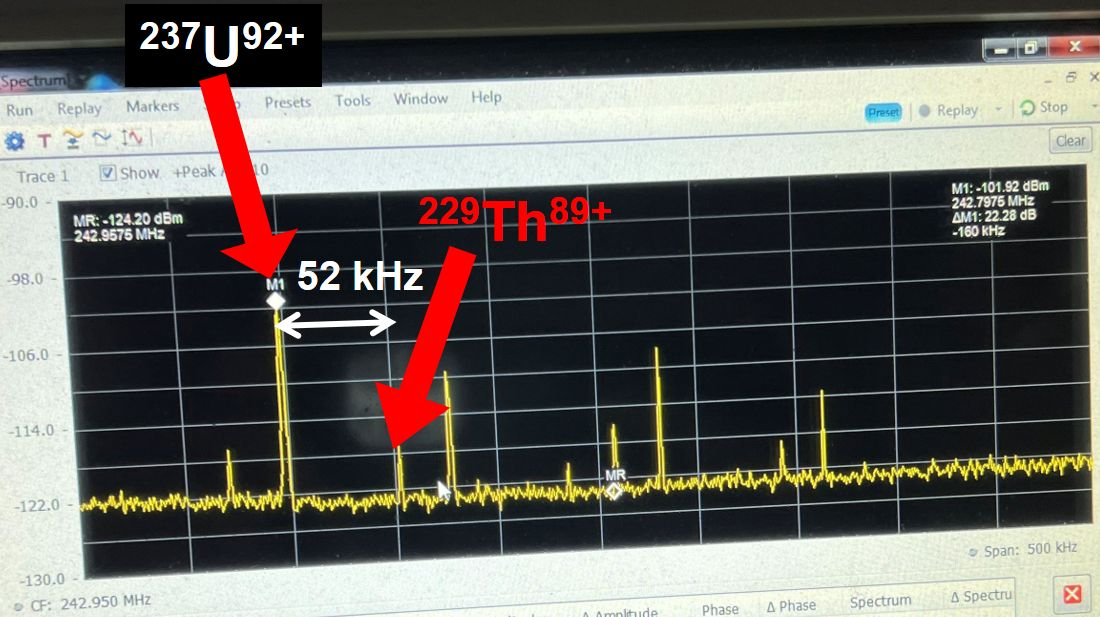
|
|
26
|
Wed Jun 18 19:05:28 2025 |
Carlo, Zac, Shahab, Ragan | Analysis | PID with rionid | For PID with rionid we used:
- LISE file from last year (attached.
- .npz file from 410 RSA (attached). |
| Attachment 1: Schermata_2025-06-18_alle_19.03.04.png
|
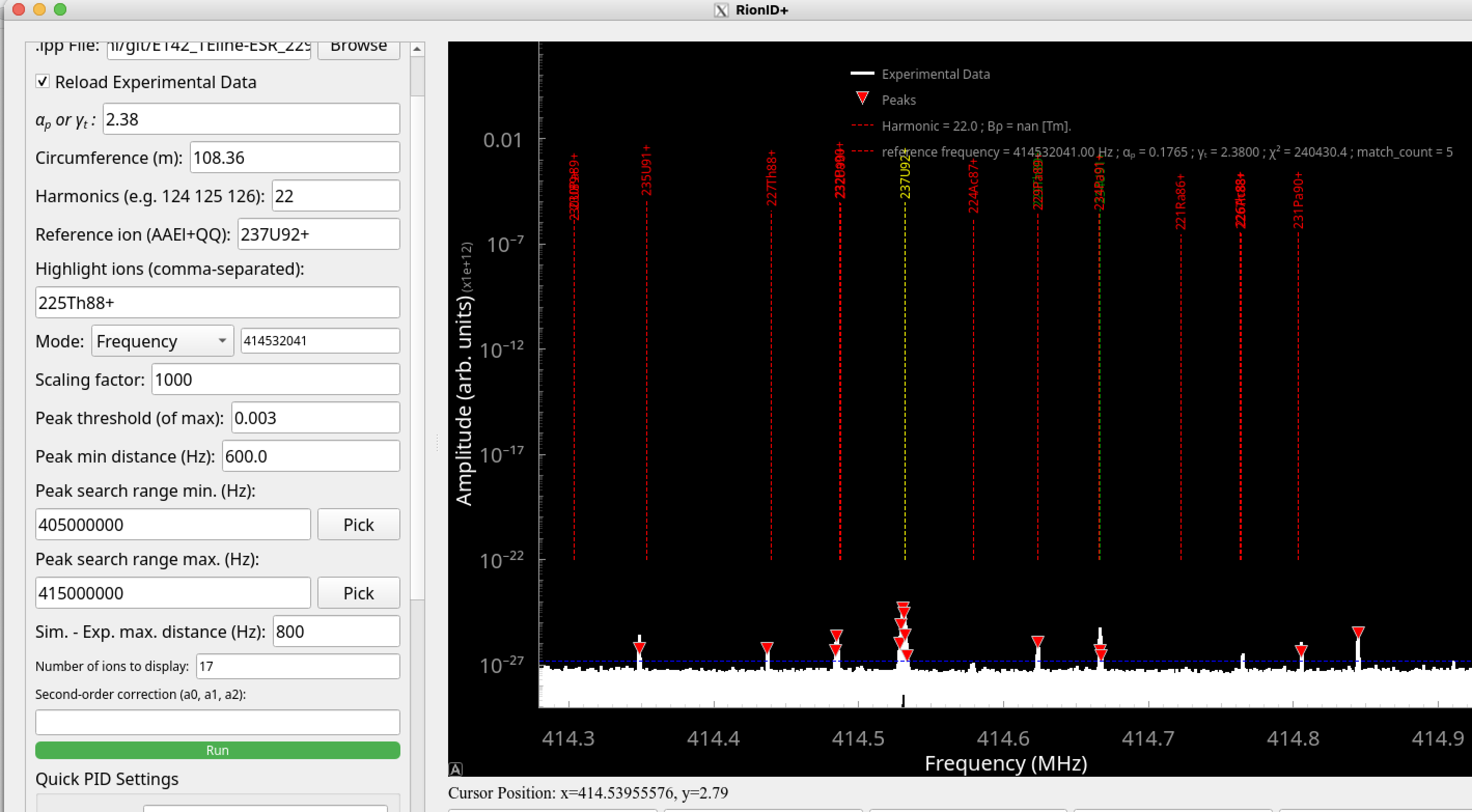
|
| Attachment 2: E142_TEline-ESR_229Th.lpp
|
Version 17.5.18
{============================= Main Part ======================================}
[general]
File = //wsl.localhost/Ubuntu-18.04/home/chenruijiu-ubuntu/experiment/ESR/2022_229Th/E142_TEline-ESR_229Th.lpp
Date = 12-06-2024
Time = 01:29:23
Configuration = GSI/FRS-TA-ESR_2014.lcn
Optionsfile = GSI_FRS_2021.lopt
Title = GSI FRS TA-ESR (2014)
BlockStructure = DSDSMDASDDD
NumberOfBlocks = 11
[settings]
A,Z,Q = 238U 92+ ; Mass ElementName Charge+ Beam
Energy = 555.9 MeV/u
Intensity = 1e+9 pps ; enA,pna,pps,kW
RF frequency = 20 MHz
Bunch length = 1 ns
Settings on A,Z = 229Th ; Mass ElementName Charge+ Beam
[OpticsBeam]
BX = 0.472 (+/-)mm ; one-half the horisontal beam extent (x)
BT = 1.59 (+/-)mrad ; one-half the horisontal beam divergence(x')
BY = 0.245 (+/-)mm ; one-half the vertical beam extent (y)
BF = 2.04 (+/-)mrad ; one-half the vertical beam divergence (y')
BL = 0 (+/-)mm
BD = 0.03 (+/-)% ; one-half of the momentum spread (dp/p)
ShiftX = 0 mm ; beam respect to the spectrometer axis
AngleX = 0 mrad ; beam respect to the spectrometer axis
ShiftY = 0 mm ; beam respect to the spectrometer axis
AngleY = 0 mrad ; beam respect to the spectrometer axis
Scheme Angle = 0 degrees
ShapeX = 1
ShapeT = 1
ShapeY = 1
ShapeF = 1
ShapeL = 1
ShapeD = 1
OptBeam_X = 1 (+/-)mm
OptBeam_T = 30 (+/-)mrad
OptBeam_Y = 1 (+/-)mm
OptBeam_F = 30 (+/-)mrad
OptBeam_L = 0 (+/-)mm
OptBeam_D = 1.5 (+/-)%
[options]
NP simple = 64 ; Number of points in distribution
NP charge states = 16 ; Number of points in distribution
NP wedge = 128 ; Number of points in distribution
Charge states = Yes ; No & Yes
CutEdgeEffect = 1 ; 1-Yes. Default, 0-no - for extended configurations
Prim.beam scatter = 0 ; 0-without, 1-with
Delta peak = 0 ; 0-without, 1-with
BrhoMeanMax = 1 ; 0-Max, 1-Mean
BrhoMeMaLeRi = 3 ; 0-Max, 1-Mean, 2-Left, 3-Right /for fission/
CentralCut = 1 ; 0-no, 1-moderate, 2-strong
[target]
Target contents = 0,4,1,9.012 ; Nomer,Z,Atoms,Mass
Target thickness = 1,1850,1.85,0,0,0 ; State,Thickness,density,angle,SolidGas,..
Target fusion compound = 0
Targ use for Q-states = 1
Target Defect = 0,0.1 ; [0] choice - % or micron at 0 degree, [1]=value;
Degrader contents = 0,6,1,12.011 ; Nomer,Z,Atoms,Mass
Degrader thickness = 0,0,2.26,0,0,0 ; State,Thickness,density,angle,SolidGas,..
Degra use for Q-states = 1
Degrader Defect = 0,0.1 ; [0] choice - % or micron at 0 degree, [1]=value;
[mechanism]
Reaction = 0 ; 0 - fragm, 1 - fusion-resid, 2 - fusion-fission
CalcOther = 1 ; calculate other reactions
V calculation = 5 ; 0 - constant, 1 - Borrel, 2 - Rami, 3-convolution, 4-two body reaction
V_opt/Vbeam = 1 ; default 1
Velocity_exceed = 1 ; 0 - without, 1-with - two-body recations velocity corrections
Binding Energy for Vf/Vp = 8 MeV ; Binding energy for Borrel's expression
Shift for Vf/Vp calc = 0
Prefragment_Rami = 1
Sigma0 = 90 MeV/c ; default 90
SigmaD = 0 MeV/c ; default 200
SigmaM = 87 MeV/c ; default 87
Asymmetry = 0 % ; default 0
Method v-sigma = 0 ; 0 - Goldhaber, 1-Morrissey,2-Friedman,3-Convolution
G_Surface = 0.95 MeV/fm^2
Symmetry around half_Ab = 1
Pfaff pickup correction = 0
ChargeExchangePfaff = 0 ; 1 - exclude, 0-forget
Sigma corr 0 = 0 ; Coulomb energy
Sigma corr 1 = 0 ; Projectile mass
Friedman mode = 2 ; 0-Qgg, 1-Surface, 2-Qgg+Surface
Prefragment_Fri = 1
Coulomb_Friedman = 1
K_Morr = 8 MeV/A ; E/A=8MeV/A default; D.Morrissey coef.
K_MorHalf = 8 MeV/A ; E/A=8MeV/A default at Afrag=Aproj/2; D.Morrissey coef.
AA_fast = 0
AA_Modefast = 3
MethodApf = 2 ; Prefragment search method: 0-N/Z direction, 1 - W*EPAX, 2 - W*CSgeom,
ExcitationApf = 1 ; Excitation energy for APF search: 0 - dSurface, 1 - dA*Ex
BarrierShape = 1 ; 0-classical, 1-quantum mech.
H_omega = 3 MeV ; default 3
Probabilty_CN = 1 ; 0/1 use Prbabilty for CN formation
UseVanishing = 1
VanishMode = 0 ; 0-Sierk, 1-Cohen
NuclPotential = 1 ; 0-Bass, 1-WS
WS_V0 = 105 MeV
WS_R0 = 1.12 fm
WS_a = 0.75 fm
FusDiffuseness = 1
Width Coef = 1 ; default 1; for Leon's charge state distribution
gZt Correction = 1 ; default 1; Leon's C.S.D.
PowerCoefLeon = 0.477 ; default 0.477; Leon's C.S.D.
Cross section = File ; Fit & File
Charge method = 3 ; charge calculations method 0-5
EPAX Cross Section = 4 ; cross section calculations method 0-4
SR Cross Section = 1 ; EPAX for SR 0-2
Energy Loss = 4 ; energy loss calculation method 0-3
Anglular straggling = 1
AngStragInOptics = 0 ; 0-LISE, 1-ATIMA
StragglingCoef1 = 0.217
StragglingCoef2 = 1.12
Energy straggling = 1 ; 0-LISE, 1-ATIMA
EnergyStragMethod = 1 ; 0-integrate, 1-table
EnergyStragShape = 0 ; 0-Gauss, 1-Landau-Vavilov
EquilThickness = 1 ; 0-Charge, 1-Global
MassMethod = 0 ; 0-DB+calcul, 1 + just calcul
MassDataBase = 0 ; 0-A&W, 1-User ME
Mass formula = 2 ; 0-LDM, 1-Myerer, 2: 1+corrections
MassExcessFile = AME2016.lme
UseChargeForEnergy = 2 ; 0-No, 1-Yes, 2-Auto
EnergyValueAuto = 30 ; default value 30 MeV/u
EquilibriumMode = 0 ; 0-Equil, 1-NonEquil
UB_Global = 70 ; default 70 MeV/u
MinZ_Global = 29 ; default Z>=29
ChargeStateOptim = 1 ; 0-No, 1-Yes
ZmQ_AfterReactn = 0 ; default 0 (full stripped)
EPAX_p_Norm = 1
EPAX_p_Un = 1.65
EPAX_p_Up0 = 1.788
EPAX_p_Up1 = 0.004721
EPAX_p_Up2 = -1.303e-5
EPAX_p_H = 1
[fission]
FisAngDistShape = 0 ; 0-isotropic; 1-anisotropic
FisMomCutForAngDist = 2 ; 0-dont use; 1-use just MatrixKinematics; 2-use for all; (default 2)
OddEvenCorrections = 1 ; 0-dont use; 1-use
PostScissionEvaporation = 1 ; 0-dont use; 1-use
DeexcitFunctionPoints = 0 ; 0- average deexcitation energy; 1- 3 points; 2 - manually
FisEXmanually = 20 ; Excitation energy manually
FisCSmanually = 1000 ; Cross section manually
FisTXEmethod = 0 ; 0-from Edissipated, 1 from Q-value
Fis_f = 0.0035 ; default 0.0045
FisEXsigma = 5.5 MeV ; default 5.5
FisCS_Global = 1e-12
FisCS_TKE = 1e-8
FisBeta1 = 0.625 ; deformation of light fragment
FisBeta2 = 0.625 ; deformation of heavy fragment
FisTKE_d = 2 fm ; d-param in Wilkins formula
FisBetaFit = 1 ; 0-manual, 1-fit
N0 = 83 ; default 82
dU0 = -2.65 ; default -2.5
C0 = 0.7 ; default 1.4
cpol0 = 0.65 ; default 0.65
width0 = 0.63 ; default 0.63
N1 = 90 ; default 90
dU1 = -3.8 ; default -5.5
C1 = 0.15 ; default 0.16
cpol1 = 0.55 ; default 0.55
width1 = 0.97 ; default 0.97
[charge_suppression]
FragInd = 1e-3
FragTotal = 1e-5
BeamInd = 1e-12
BeamTotal = 1e-15
[convolution]
Convolution mode = 1 ; 0-Qgg, 1-Surface, 2-E* per Abraded nucleon
Sigma_0 = 91.5
Sigma_1 = 91.5
Sigma_2 = 160
CoefConv_0 = 3.344
CoefConv_1 = 3
CoefConv_2 = 1
ShiftConv_0 = 0.1581
ShiftConv_1 = 0.1487
ShiftConv_2 = -1
[evaporation]
NP evaporation = 32 ; Number of points in distribution
NPevapFis = 8 ; Number of points in distribution
EvapMethod = 2
StateDensityMode = 2 ; 0, 1+pairing, 2+shell
EvapUnstableNuclei = 1 ; 0 - only stable,1 +unstable
Tunnelling = 1
AvoidUnboundCS = 1
ProtectedChannels = 1
R_Evaporation = 5.7 fm ; correction for the effective Coulomb barrier
Mode_Apf_manual = 0 ; 1-manual, 0-auto
Energy_in_T = 2 ; default 2
EvaporationVelocity = 0 ; 0 - quality, 1 -fast
DeltaOddEvenEvap = 12
DeltaOddEvenFission = 14
BreakupTemperature250 = 4.7
BreakupTemperature150 = 5.9
BreakupTemperature050 = 8
BreakupDiffuseness = 0.05
DissipationKramers = 0
DissipationStepFunction = 1
DissipationBeta = 1 ; default 2.0
mode_1n = 1
mode_2n = 0
mode_1p = 1
mode_2p = 0
mode_a = 1
mode_d = 0
mode_t = 0
mode_3he = 0
mode_fis = 1
mode_brk_up = 1
mode_gamma = 0
[fission_barrier]
FissionBarrierFactor = 1
FissionBarrierMode = 1 ; #0-4
OddEvenCorrections = 1
ShellCorrections = 1
FB_InOutMax = 2 ; #0-2 - in/out/max
ModeForUser = 1 ; #0-2
NdeltaOddEven = 2.5
ZdeltaOddEven = 9
[excitation_energy]
AbrasionModel = 0 ; 0-Geometrical, 1-Exponential
GeomAA_Correction = 1 ; 0 - don't use,1 - use -default
Thermalization = 0
ThermaTimeCoef = 3e+0 ; 2.1e-22 MeV *s/e(t)
AbraExpSlope = 0.363
Friction = 0 ; 0 - off,1 - on
Ev_A_SigmaCoef = 9.6
G_FrictionCoef1 = 6.5
G_FrictionCoef2 = 0.5
G_FactorCoef1 = 1.5
G_FactorCoef2 = 2.5
DepthHole = 40
EnergyCoef_CB0 = 0
EnergyCoef_CB1 = 27
EnergyCoef_CB2 = 0
SigmaCoef_CB0 = 0
SigmaCoef_CB1 = 18
SigmaCoef_CB2 = 0
D_MeanTemp = 13
DN_MeanTemp = 0
DZ_MeanTemp = 0
LN_median = 20
LN_variance = 20
LN2_median = 0
LN2_variance = 0
AA_factor = 1
ApplyLimitTemp = 0
[evapauto]
tun_a0 = -0.61392
tun_a1 = 0.44559
tun_a2 = 0.12008
A_Bound = 300
A_Pairing = 1
[plot]
Start target = Detector ; Detector & RF
Start of TOF = T1
Stop of TOF = M1
dE-detector-1st = M1
dE-detector-2nd = M1
TKE-detector = M1
X-detector = M1
Y-detector = M1
Tilting = M1
Stopper = M2
RO_Wedge = W1
ConditionBlock = A0
Plot threshold = 1e-10 pps ; minimal value for plot scale
Shift of TOF for RF = 0 ns ; for dE-TOF plot with RF
Fraction of RF trigger = 1
UseCondition = 0
TKE_calibration = 1,1,0,MeV
[cs_file]
UserDiffCS = 0 ; Number of User Diff CS saved in this file
AppendOverwrite = 1
AttachedInside = 1
ShowCSinPlot = 1
Chi2 = 1
[sec_reactions]
NP sec.reactions = 32 ; Number of points in distribution
Secondary reactions = 0
fiss_FilterUse0 = 1
fiss_FilterUse1 = 1
fiss_FilterUse2 = 1
... 3039 more lines ...
|
| Attachment 3: RSA01-2025.06.18.18.06.02.162.tiq_spectrum.npz
|
| Attachment 4: Schermata_2025-06-18_alle_19.32.53.png
|
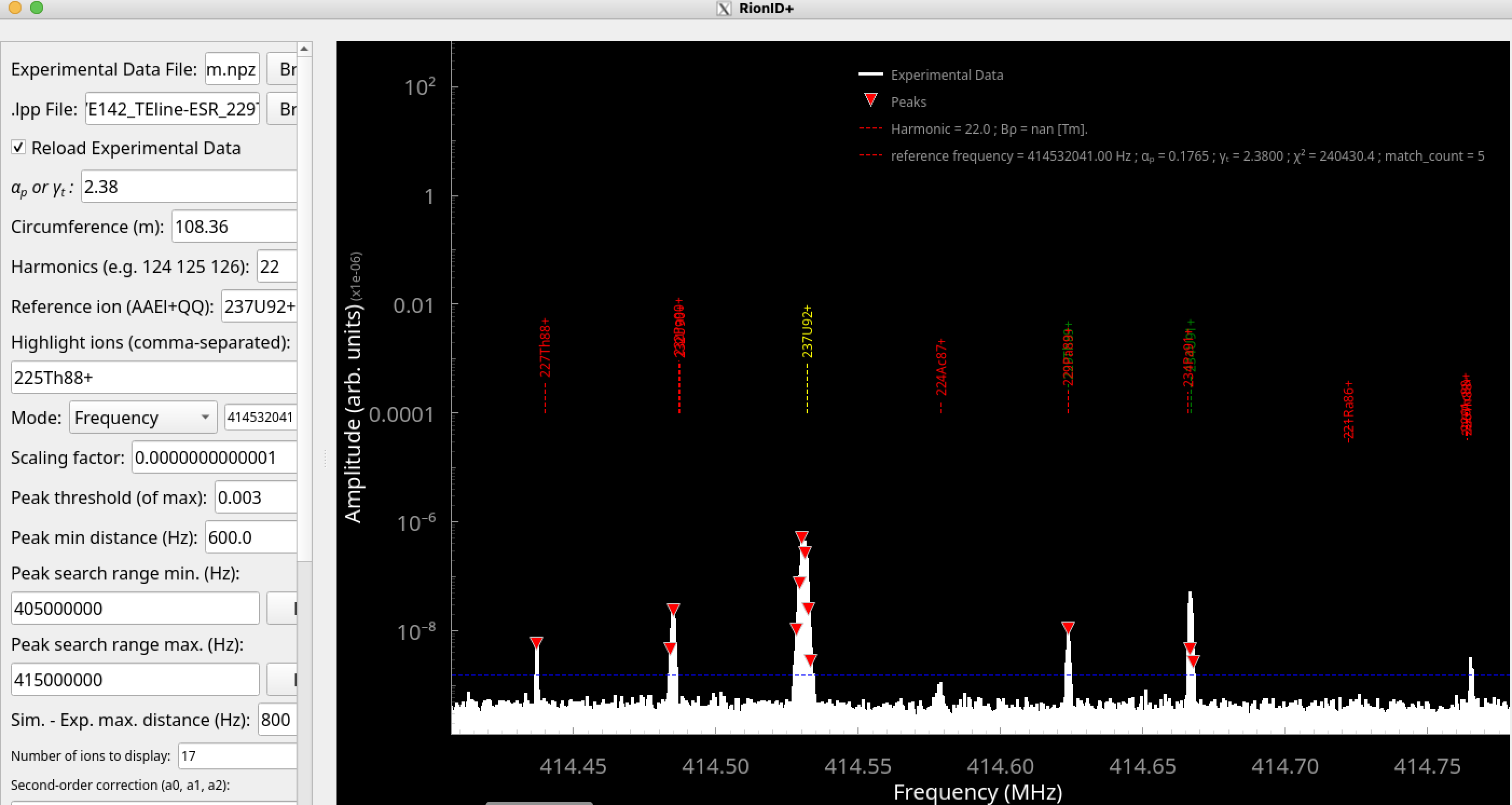
|
|
25
|
Wed Jun 18 14:01:40 2025 |
Julien, Konstantin, Stefan, Rima | | Ion bunch on PMTs | Apparentlty did not work yesterday evening (no signal), but looks fine now (see attachment) |
| Attachment 1: Bildschirmfoto_bunch_on_PMT_2025-06-18_14-11-44.png
|
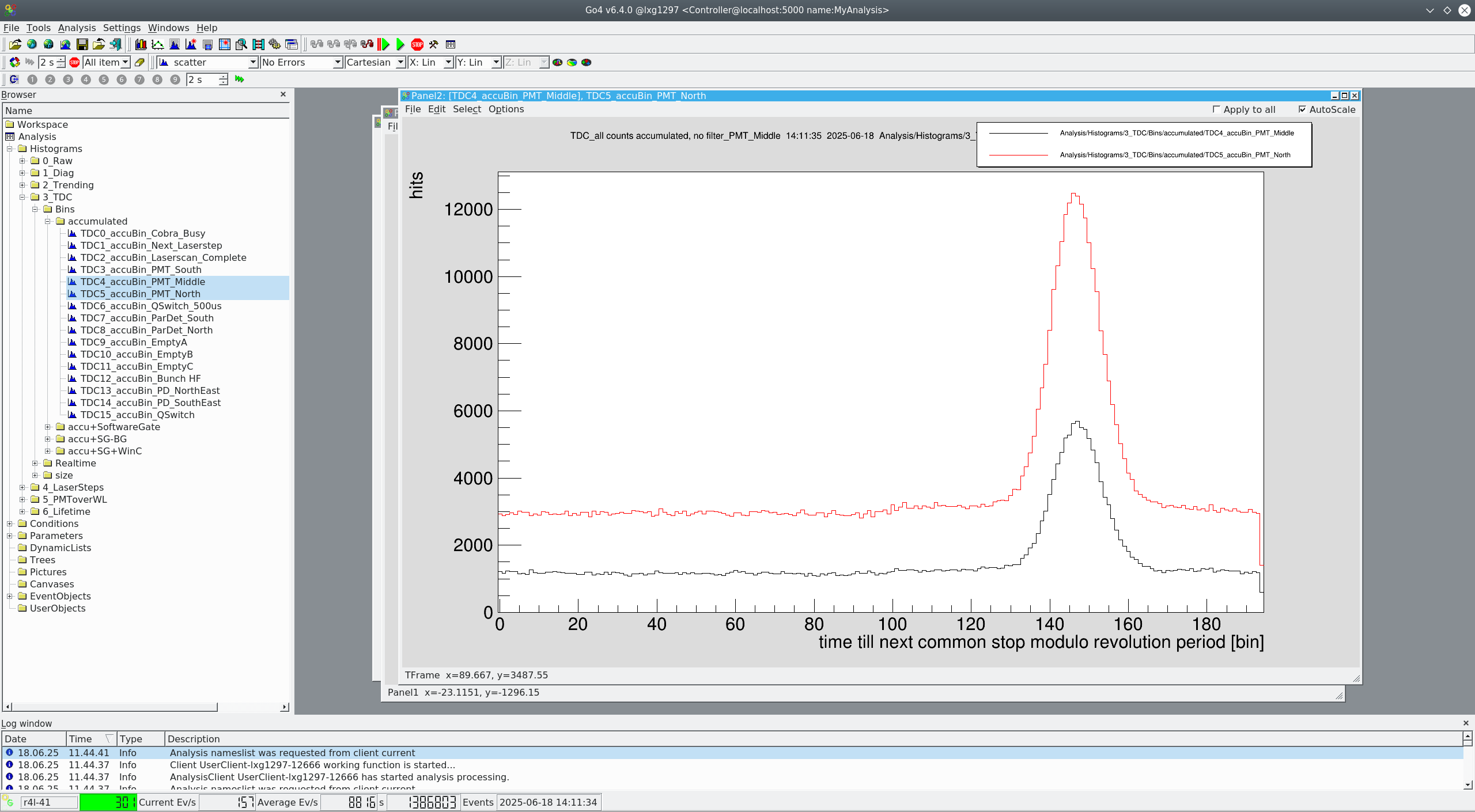
|
|
24
|
Wed Jun 18 11:44:15 2025 |
Julien, Konstantin, Stefan, Rima | | Jitter CFD | Pulses on photodiodes in entry 20
1. seem wide, so we also looked at qswitch signal; also seemes wide.
2. Have a tail
1.:
We investigated this and came to the conclusion, that the CFD is the issue:
- On an oscilloscope, when looking at both HF signal (CFD input) and CFD output, there is a 2ns jitter.
- The same jitter is visible when looking at the CFD output when triggering on a freq. generator signal with same frequency and amplitude as HF signal (1.54263 MHz; 1V peak to peak).
- There is not significant jitter when comparing the CFD output and the qswitch signal
We tried differents CFD (also a leading edge CFD / different thresholds), but this did not significantly improve what we saw on the oscilloscope.
Applying a 10MHz filter to the HF signal only made the jitter worse.
There might be an option to get a logic (NIM) signal from ESR instead of the sin-signal
Alternatively, one could think about using a PLL.
Note: the 2ns might also be limited by the trigger of the oscilloscope. We saw that if the trigger of the oscilloscope is not on the steepest part of the HF signal, the jitter "gets worse".
2.:
We saw on the qswtich signal, that there are instances, when the q-switch signal is too early;
Ww will try to find out which NIM module between the CFD and the final qswitch signal causes this
Preliminary: It's coincidance crate |
|
23
|
Wed Jun 18 08:07:17 2025 |
Julien, Konstantin | Laser | new FCU Calibration | UV power was not stable but dropping from ~18 mW to 13 mW after opening COBRA shutters.
New calibration of frequency conversion unit:
Wavelength/nm Position/Steps
554,0001 383029
553,0000 386604
552,0001 390229
551,0000 393954
550,0001 397679
549,0001 401404
548,0001 405104
547,0001 408829
now stable at ~19-20 mJ depending on wavelength
Table of dataset: Attachement 1
Plot of dataset: Attachement 2 |
| Attachment 1: 2025_06_18_FCU_Cal_Table.JPG
|
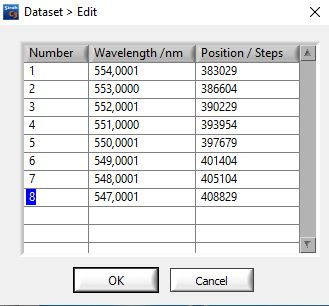
|
| Attachment 2: 2025_06_18_FCU_Cal_Plot.JPG
|
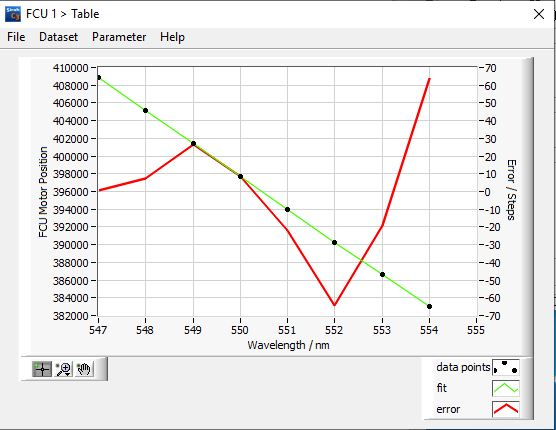
|
|
22
|
Wed Jun 18 07:59:00 2025 |
Julien, Konstantin | Laser | Phase-offset | We recognized that the output power of the pump laser was instable when externally triggered with 200kHz (stand-bye frequency of ESR). Therefore, we changed the coarse timing offset of the pockels cell trigger compared to the flash lamp pulse from 215µs to 219.9µs.
Thereby, the output power increased from ~600mJ to 620mJ, and the PTP stability improved from 15% to 10%. The RMS stability improved from 2% to 1.2 %. With these settings we had UV pulse energies of 20mJ. |
| Attachment 1: IMG_3889.jpg
|
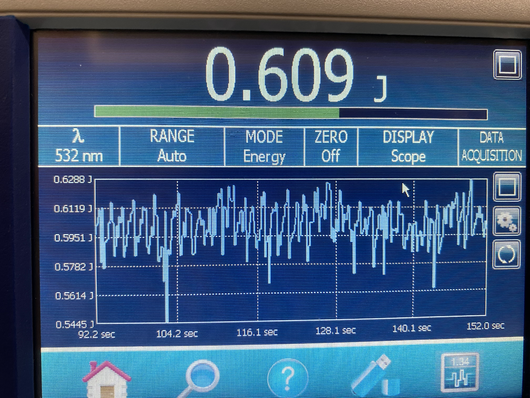
|
| Attachment 2: IMG_3888.jpg
|
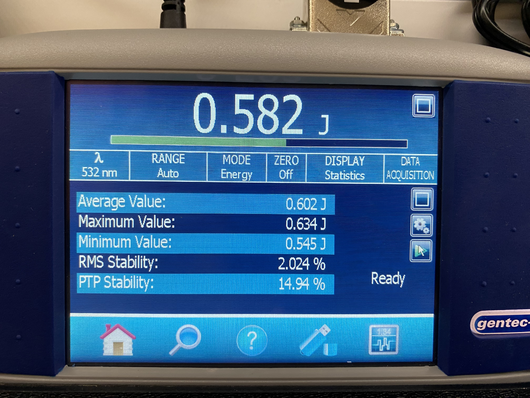
|
| Attachment 3: IMG_3891.jpg
|
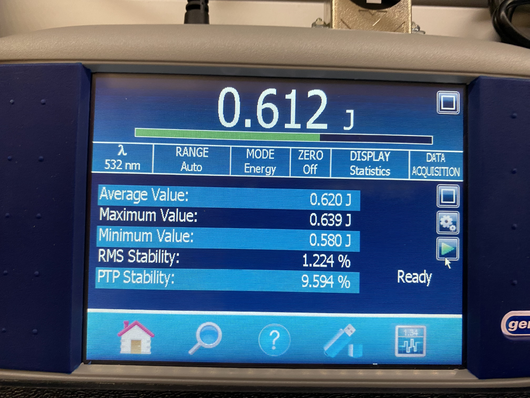
|
| Attachment 4: IMG_3892.jpg
|
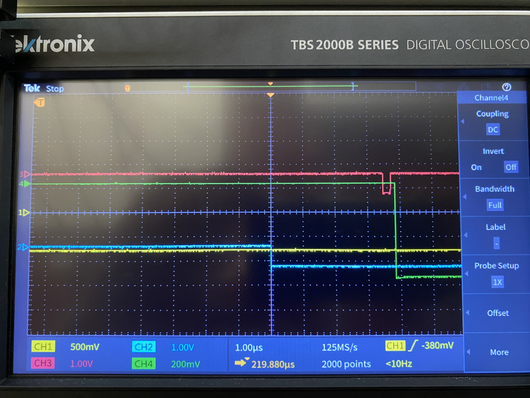
|
|
21
|
Wed Jun 18 03:12:25 2025 |
Rodolfo | Laser | Beam Stabilization | | The laser beam pointing has changed, even thought the MRC settings are the same as given in Entry 5 (this elog). This could be caused by a droping of the laser output energy which is now 13,8 mJ @275 nm |
| Attachment 1: MRC-Settings_2025_06-18.JPG
|
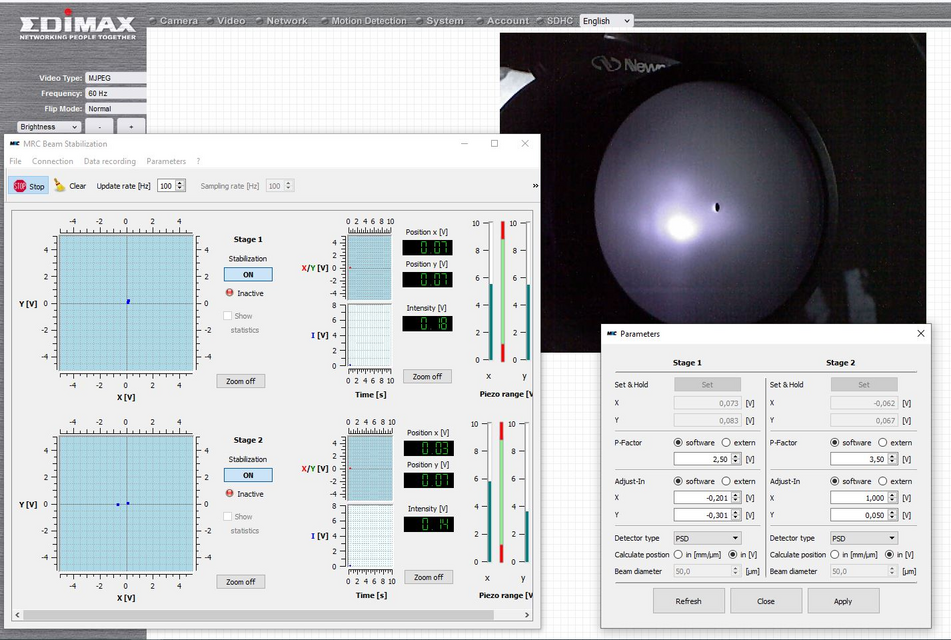
|
|
20
|
Wed Jun 18 01:58:02 2025 |
Esther, Alexis, Anton, Rodolfo, Carsten | Accelerator | No Bunched Beam | | The Bunching is not set properly. We do not see the ion bunch with the Photomultiplier. |
| Attachment 1: Bildschirmfoto_PD_PMTSouth_2025-06-18_1.png
|
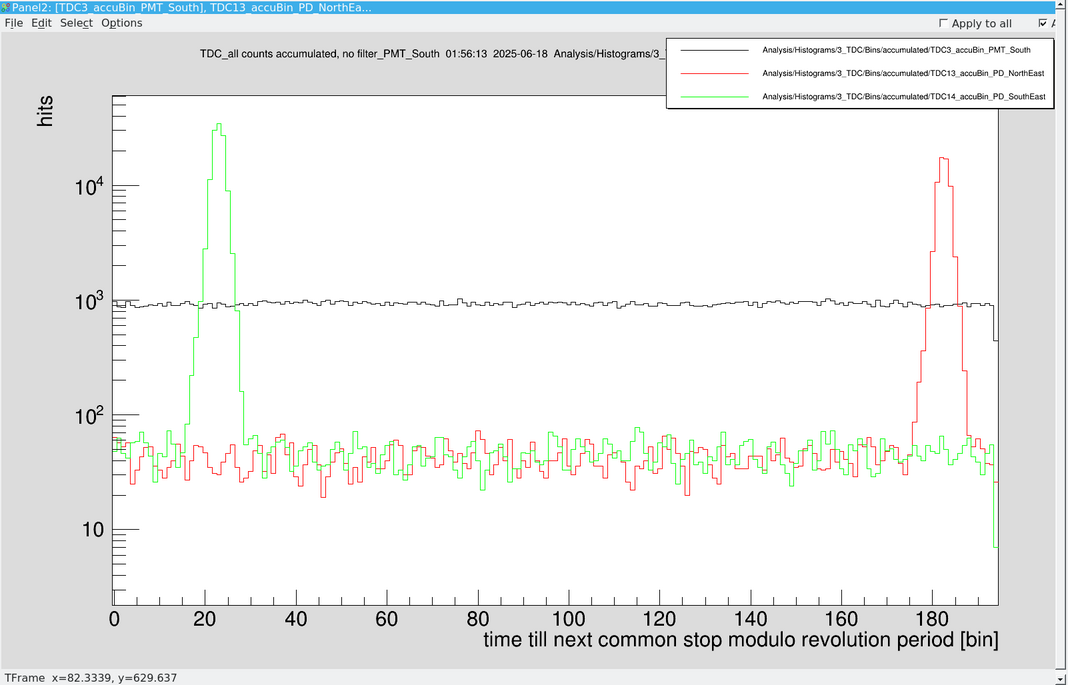
|
|
19
|
Wed Jun 18 00:56:28 2025 |
Carsten, Rodolfo, Anton, Alexis, Esther | | beam overlap with t-scrapers | When testing the overlap between laser and ion beam we observed the following positions:
|
motor | ion beam position (mm) from outside | ion beam position (mm) from inside
| |
GECEDS1VU | 0 | 6.5
| |
GECEDS1HA | -22.5 | -13.5
| |
GECEDS2VU | 1 | 8.5
| |
GECEDS2HA | -20.5 | -10
|
Note: To move GECEDS1VU the corresponding horizontal drive (GECEDS1HA) has to be at 2 mm. |
|
18
|
Wed Jun 18 00:33:56 2025 |
Esther, Alexis, Anton, Rodolfo, Carsten | DAQ | R4l-41 | | We have some issues with the RIO computer R4l-41 (DAQ1). We had to switch off completely twice. Only then it reacted properly. Maybe a problem with the network at about 00:00 o'clock? |
|
17
|
Tue Jun 17 19:25:30 2025 |
Rodolfo | Accelerator | T-Scrapers in E-Cooler | Here are the instructions to drive the T-Scrapers inside the ESR Electron Cooler
- ECEDS1VU: Verriegelt mit ECEDS1HA. Der Antrieb kann nur fahren
wenn der Antrieb ECEDS1HA in Position -4,0 steht.
- ECEDS1HA: Verriegelt mit ECEDS1VU. Der Antrieb kann nur fahren
wenn der Antrieb ECEDS1VU in Stellung EI steht.
- ECEDS2VU: Verriegelt mit ECEDS2HA. Der Antrieb kann nur fahren
wenn der Antrieb ECEDS2HA in Position 0,0 steht.
- ECEDS2HA: Verriegelt mit ECEDS2VU. Der Antrieb kann nur fahren
wenn der Antrieb ECEDS2VU in Stellung EI steht.
According to Boywitt/Schuhmacher, BEA-MEI. Date: 28.07.2021 |
| Attachment 1: Scrapereinstellung_am_E-Kühler.pdf
|
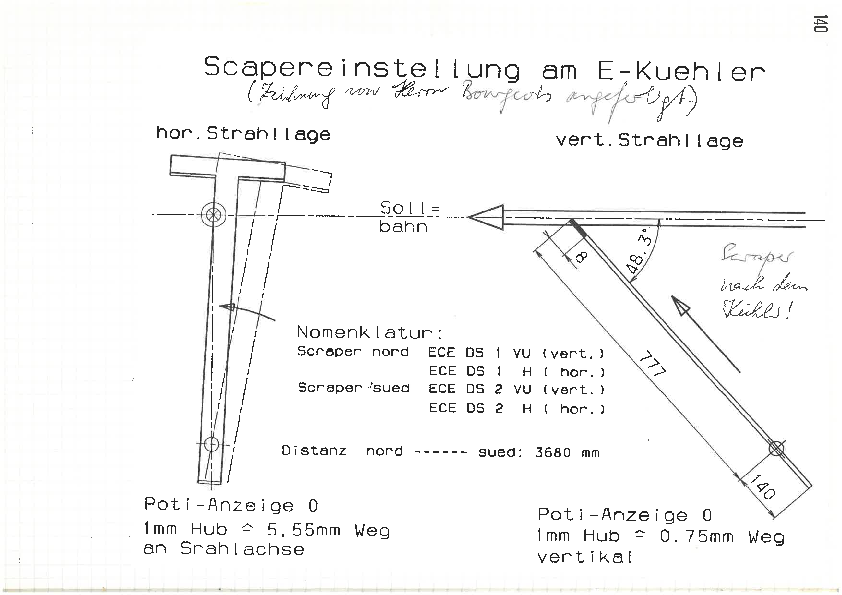
|
|
16
|
Tue Jun 17 16:33:16 2025 |
Carsten, Simon | DAQ | Gate Q-swtich | The gate generator of the Q-switch signal for the Vuprom TDC was set to 10ms. |
|
14
|
Mon Jun 16 22:27:01 2025 |
Carsten, Simon | DAQ | Thresholds | We also adjusted the thresholds for the mesytic.
Doing that, we noticed that one of the trafos is broken (5th row, middle).
|
PMT | channel | Threshold
| |
South | 5 | 35
| |
Middle | 6 | 16
| |
North | 7 | 16
|
|
|